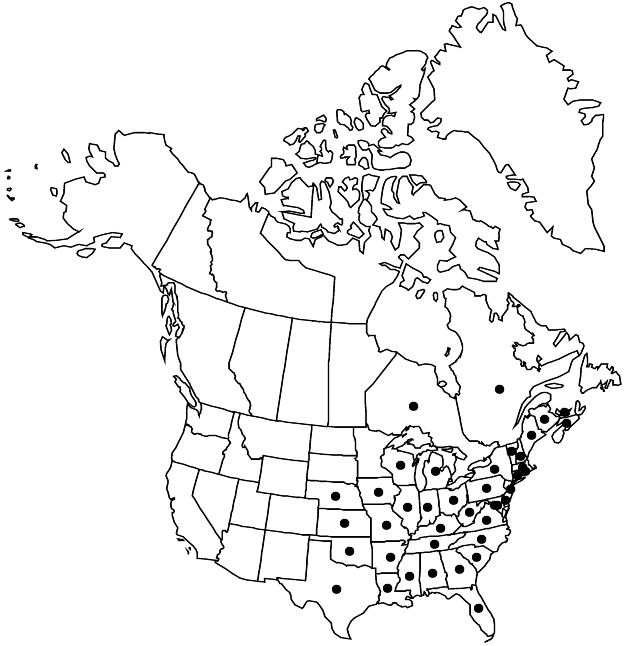Rosa carolina
Sp. Pl. 1: 492. 1753.
Shrubs or subshrubs, forming scattered populations. Stems spreading and weak, sometimes erect, slender, 3–10(–13) dm, openly branched; bark dull reddish brown, glabrous; infrastipular prickles usually paired, erect, sometimes declined, rarely curved, flat, subulate, (2–)3–9 × 1.5–3 mm, base glabrous, internodal prickles sparsely or densely mixed with aciculi, stipitate glands and smaller internodal prickles. Leaves 5–10(–16) cm; stipules 10–18(–23) × 2–3 mm, auricles flared, 2–4 mm, margins entire or subserrate, eglandular or finely stipitate-glandular, surfaces glabrous, rarely puberulent, eglandular; petiole and rachis sometimes with pricklets 3 mm, aciculi few, glabrous, rarely pubescent, rarely stipitate-glandular; leaflets (3–)5–7(–9), terminal: petiolule 4–11 mm, blade ovate, elliptic, or lanceolate, 18–50 × 9–28 mm, membranous, base cuneate, margins 1–2+-serrate, teeth 8–14(–18) per side, eglandular or gland-tipped, apex acute to acuminate, rarely obtuse, abaxial surfaces pale green, glabrous, rarely pubescent, eglandular or glandular, adaxial usually green, dull, rarely slightly lustrous, glabrous. Inflorescences corymbs, 1–3(–6)-flowered. Pedicels erect, slender, 5–19 mm, glabrous, sparsely to ± densely stipitate-glandular, sometimes eglandular; bracts 2, lanceolate, 10–17 × 2–4 mm, margins entire, usually eglandular, surfaces with sparse hairs, stipitate-glandular. Flowers 3–5.5 cm diam.; hypanthium globose or ovoid, 4–6(–8) × 3.5–5(–8) mm, glabrous, ± densely to sparsely stipitate-glandular, sometimes eglandular, neck (0–)0.5–1 × 2 mm; sepals reflexed, sometimes spreading, lanceolate, 10–22 × 2–3 mm, tip 2–10 × 0.5–1 mm, margins pinnatifid or entire, abaxial surfaces rarely puberulent, stipitate-glandular, rarely eglandular; petals single, pink, 15–24 × 13–19 mm; stamens 105; carpels 32–46, styles exsert 1 mm beyond stylar orifice (1.5–2 mm diam.) of hypanthial disc (4–5 mm diam.). Hips red or orange-red, globose or depressed-globose, rarely ellipsoid, 7–14 × 6–15 mm, fleshy, glabrous, densely to sparsely stipitate-glandular, sometimes eglandular, neck 0–0.5 × 5–6 mm; sepals early deciduous, spreading to reflexed. Achenes basal, 2–6(–10), tan, 4–5 × 2.5–3 mm.
Distribution

N.B., N.S., Ont., P.E.I., Que., Ala., Ark., Conn., D.C., Del., Fla., Ga., Ill., Ind., Iowa, Kans., Ky., La., Maine, Mass., Md., Mich., Miss., Mo., N.C., N.H., N.J., N.Y., Nebr., Ohio, Okla., Pa., R.I., S.C., Tenn., Tex., Va., Vt., W.Va., Wis., ne Mexico.
Discussion
Subspecies 3 (2 in the flora).
Rosa carolina is a polymorphic allotetraploid derived from diploids found in eastern North America (S. Joly et al. 2006). Two nothospecies representing presumptive secondary hybridization and introgression are R. ×medioccidentis W. H. Lewis (R. arkansana × R. carolina) in Iowa, eastern Kansas, and western Missouri, and R. ×novae-angliae W. H. Lewis (R. carolina × R. virginiana) of New England, infrequently south to the District of Columbia, nearby Virginia, and New Jersey (W. H. Lewis 2008).
The Menominee of Wisconsin once ate hips of Rosa carolina to treat gastrointestinal problems (H. I. Smith 1923).
Subspecies mexicoensis W. H. Lewis is found in the Sierra Madre Oriental of northeastern Mexico (Coahuila, Nuevo León, Tamaulipas).
Selected References
Key
| 1 | Stems spreading, sometimes erect; prickles (rarely absent) infrastipular, infrequently mixed with sparse, shorter internodal prickles and aciculi not to apices, eglandular; most common in e United States. | Rosa carolina subsp. carolina |
| 1 | Stems erect; prickles infrastipular, mixed with dense, shorter internodal, aciculi, and sparse stipitate glands to apices; epicenter in the Ozark Plateau and surrounding states. | Rosa carolina subsp. subserrulata |